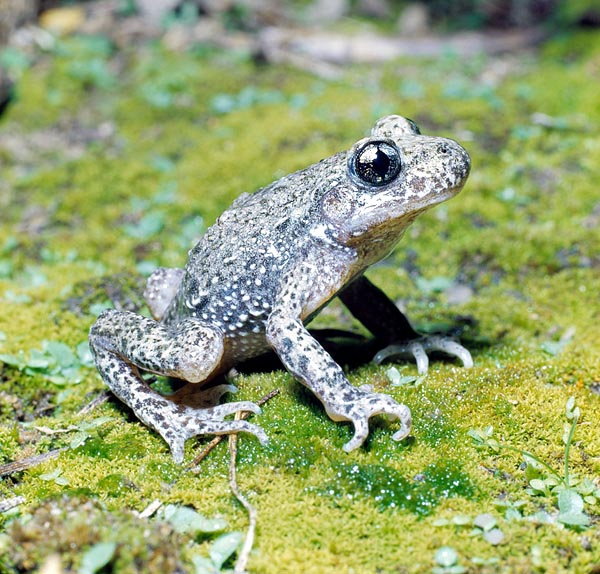Family : Discoglossidae

Text © DrSc Giuliano Russini – Biologist Zoologist

English translation by Mario Beltramini

In the reproductive time, the Alytes obstetricans male cares the eggs © Giuseppe Mazza
Zoogeography
It is present in the whole Western Europe, from south to north. It is found from the sea level up to the 2.500 me of altitude, as observed in the French and Spanish Pyrenees.
Ecology-Habitat
The obstetrical toad is a species with a mainly nocturnal activity and has totally terrestrial habits. It mostly frequents woods, gardens, troughs, drywalls, quarries, sand dunes and rock landslides. It nourishes of larvae of insects and of adult insects, as well as of small molluscs and terrestrial worms.
Morpho-physiology
It’s a small and chubby species, with a length going from the 3 to 5 cm; the forelegs are strong, good for digging. The eyes are very prominent with vertical pupils. The livery, in both sexes, can be green, ash grey or brown, often with darker decorations. There is absence of sexual dimorphism.
Ethology-Reproductive Biology
During the mating, the male calls the female from a den, for instance a crevice, producing a characteristic acute call “poo…poo”. At this stage, the female, induced to the ovulation, emits a long string of eggs, which she will put on the back, the male fecundates them with the sperm, and then they will be transferred from the female to the male, who places them in jelly cords, wrapped around its hind legs.
The male carries the eggs till when the time of hatching will come: by then, it will release them in low waters, for instance those of a pond or a puddle of water, where the tadpoles will be able to develop freely. This particular form of father’s parental care is essentially an active form of defence of the progeny.
Synonyms
Alytes (Alytes) obstetricans almogavarii García-París, Monton & Alonso-Zarazaga, 2004; Alytes (Alytes) obstetricans boscai Dubois, 1987; Alytes (Alytes) obstetricans obstetricans Dubois, 1987; Alytes (Alytes) obstetricans pertinax García-París, Monton & Alonso-Zarazaga, 2004; Alytes campanisonus boscai Lindholm, 1929; Alytes obstetricans almogavarii Arntzen & García-París, 1995; Alytes obstetricans boscai Lataste, 1879; Alytes obstetricans obstretricans Lataste, 1879; Alytes obstetricans pertinax García-París & Martinez-Solano, 2001; Alytes obstetricans var. boscae Boulenger, 1882; Alytes obstetricans var. Boscae Schreiber, 1912; Alytes obstetricans Lataste, 1879; Alytes obstetricans Wagler, 1830; Bombinator obstetricans Merrem, 1820; Bufo obstetricans Laurenti, 1768; Obstetricans vulgaris Dugès, 1834; Rana obstetricans Wolf in Sturm, 1828.
→ For general notions about Anura please click here.
→ To appreciate the biodiversity within the FROGS please click here.
